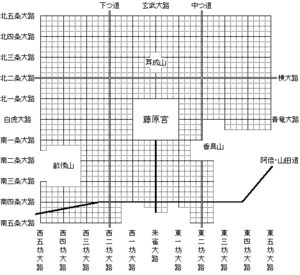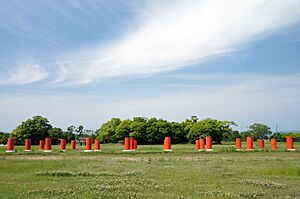Fujiwara-kyō facts for kids
Fujiwara-kyō (藤原京) was an important capital of Japan a long time ago. It was the main city for sixteen years, from 694 to 710. You can find its old location in what is now Kashihara in Nara Prefecture. Before Fujiwara-kyō, the capital was in a nearby place called Asuka. Interestingly, the old history books didn't call it Fujiwara-kyō; they called it Aramashi-kyō (新益京).
People started building Fujiwara-kyō around 682, when Emperor Tenmu was ruling. Building stopped for a short time after he passed away. Then, Empress Jitō continued the work and officially made it the capital in 694. Fujiwara-kyō stayed the capital during the reigns of Emperor Monmu and Empress Genmei. But in 710, the Imperial court moved to the Heijō Palace in Nara. This move started a new time in Japanese history called the Nara period.
History of Fujiwara-kyō
Fujiwara-kyō was the very first capital city in Japan built in a special grid pattern. This design was inspired by cities in China. Recent studies show that the city was much larger than people first thought, covering an area of about 5 square kilometers. The main palace was huge, about 1 square kilometer in size. It was surrounded by strong walls that were about 5 meters high.
Each of the four walls around the palace had three gates. The most important gate was called Suzakumon, and it was in the middle of the south wall. The main palace buildings, like the Daigokuden (大極殿), were the first in Japan to have roofs made of tiles, just like in China.
The area where Fujiwara-kyō was built used to belong to the Nakatomi clan. This family was in charge of performing important Shintō religious ceremonies for the Emperor and Empress. Sadly, the city burned down in 711, just one year after the capital moved to Nara. It was never rebuilt after that fire.
Archaeologists started digging at the site in 1934. They have found many interesting things, including almost 10,000 wooden tablets. These tablets, called mokkan, have Chinese writing on them. They tell us a lot about daily life and government back then.
Empress Jitō, who moved the capital to Fujiwara-kyō, even wrote a beautiful poem about the city in summer:
春すぎて夏来にけらし白妙の
衣ほすてふ天の香具山
haru sugite natsu kinikerashi shirotae no
koromo hosu chō Ama no Kaguyama
Spring has passed, and it seems summer has arrived;
They say this is the time when white robes are hung to dry on heavenly Mount Kagu.
(Shin Kokin Wakashū 3:175; Hyakunin Isshu 2)
Empress Genmei moved the capital from Fujiwara-kyō to Nara in 710. She did this mainly because her son, Emperor Monmu, had wanted a new capital. He had ordered people to find a good new capital site in 697. Some historians believe that Emperor Monmu wanted a new capital because of an old belief. This belief said that a new Emperor should rule from a new capital city. Nara was planned to be the capital for his son, Emperor Shōmu.
What Fujiwara-kyō Looks Like Today
Today, you can still see the earthen platform where the Daigokuden building of Fujiwara Palace once stood. The area around it has been turned into a historical park. About 60% of the old Fujiwara Palace site is now a special historical place in Japan. Archaeologists are still working there, continuing to dig and learn more about the past.
In 2007, the Japanese government suggested that "Asuka-Fujiwara: Archaeological Sites of Japan's Ancient Capitals and Related Properties" should become a World Heritage Site. This is a big step towards protecting these important historical places for everyone to see.
Since 2006, local towns have worked together on a special project. They plant beautiful flowers at the Fujiwara Palace site to help more people learn about this historical place. In spring, you can see about 2.5 million Nanohana flowers blooming. In summer, there are about 1 million yellow cosmos flowers and 11 different kinds of lotus flowers. In autumn, about 3 million cosmos flowers cover the fields. It's a truly colorful sight!
- Flower Garden Planting Project
-
Lotus flowers
See also
 In Spanish: Fujiwara-kyō para niños
In Spanish: Fujiwara-kyō para niños







